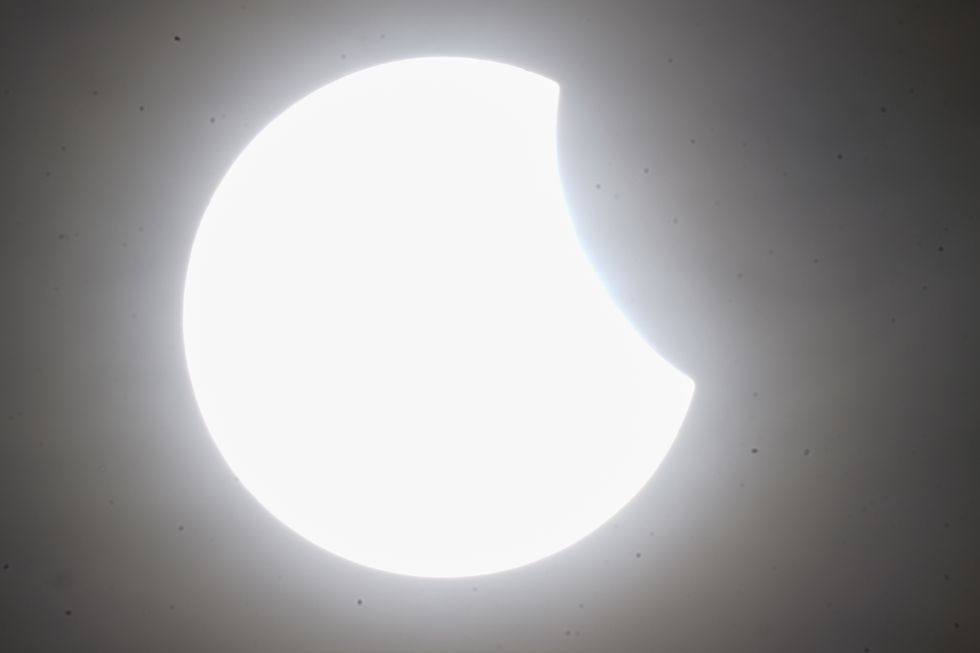
Skygazers Witness Partial Solar Eclipse
Community Gatherings to Witness a Partial Solar Eclipse

Across the United Kingdom, people stepped outside on Saturday morning to witness a remarkable celestial event: a partial solar eclipse. In communities large and small, sky watchers gathered with their protective eclipse glasses, telescopes, and homemade pinhole devices, all set to capture a rare moment when the Moon slides in front of the Sun.
On that day, the Moon did not completely cover the Sun but created a fascinating “bite” out of it. This happens when the Moon passes between the Sun and the Earth, but the three bodies aren’t perfectly aligned.
As a result, only a portion of the Sun is obscured. Throughout the morning, residents in various parts of the country enjoyed the unusual sight, even if the experience looked slightly different from one location to another.
In London, the eclipse reached its peak around 11 am, though many parts of the UK saw the event between about 10 am and noon. Enthusiasts in every region took advantage of the daytime spectacle. In the town of Lewes in Sussex, the excitement was palpable.
Robert Massey, the deputy executive director of the Royal Astronomical Society, was among those enjoying the show.
Speaking at around 11 am, he described the scene: “There’s a really nice crowd of people, everybody’s really excited, there’s people wearing eclipse glasses, looking through the telescopes we’ve got set up. We’re loving it and it’s a lot of fun. It’s a great public atmosphere, it’s a really nice event. There’s a huge amount of enthusiasm about it.”
The partial solar eclipse, as viewed from Warwickshire, offered a captivating spectacle.
Massey explained that the Moon had started moving in front of the Sun about an hour before he spoke and that the eclipse would continue for a bit longer. “As expected, the Moon started moving in front of the Sun about an hour ago; it’s got a bit under an hour to go and it’s blocking out some of the Sun,” he added.
For him and many others, watching the eclipse wasn’t about dramatic changes to the environment - “It’s not like the landscape or the light looks different if you’re not looking at the eclipse”, but rather the striking image seen when observing through a telescope.
He pointed out, “if you’re looking through a telescope then you see this really obvious bite. One of my colleagues here has a colander and through that, you can see little pinholes of the sun with the bite out of it as well.”
 Jacob King
Jacob KingWhat made this event even more special was the sheer number of people tuning in. With local astronomy groups hosting events throughout the UK, the eclipse brought together tens of thousands of curious observers who were eager to experience this rare moment in time.
For many, it was not just a scientific occurrence but also a shared experience that united communities. These gatherings allowed people to enjoy both the beauty of the event and the opportunity to learn more about astronomy in an engaging, communal setting.
A partial solar eclipse graced the skies over Warwickshire.
Elsewhere, astronomers like Imo Bell at the Royal Observatory Greenwich also shared their thoughts. Speaking around 11:15 am, Bell noted, “There’s been nothing unexpected, but that’s the cool thing, we’ve known this has been coming for a very long time. We have the technology and the understanding of space now to predict these things almost to the second.”
Standing in Oxford during the event, Bell reported that the eclipse was reaching more than 30% obscurity of the Sun, a figure that made for a satisfying observation for those who had prepared for this day.
He also mentioned that while many in the UK were enjoying clear skies, others in areas with heavier cloud coverage might not have been as fortunate. “I’ve heard a lot of people in the UK, where they have higher obscurity, have bad cloud coverage, though. If you’ve got good weather, you’re pretty lucky,” Bell said.
 Jacob King
Jacob KingThe excitement of the day was heightened by practical information from the Met Office. Earlier on Saturday, they had indicated that southern and eastern parts of the UK would have the best conditions for observing the eclipse.
In contrast, those in the north and west were likely to encounter cloudier skies, which might have reduced the visibility of the phenomenon. This mix of weather conditions added a layer of anticipation and luck to the experience; if you were in the right place at the right time, you would see a truly memorable sight.
A partial solar eclipse graces Liverpool's waterfront, silhouetting the iconic Royal Liver Building. 5/5
 Peter Byrne
Peter ByrneLooking forward, astronomy enthusiasts already have another event to anticipate. The next partial solar eclipse visible in the UK is scheduled for August 2026 and is expected to reach a dramatic 90% obscuration.
With events like Saturday’s gathering, it’s clear that the passion for observing the skies remains strong across the country, as people continue to find both wonder and community in these astronomical occurrences.
Damjan







